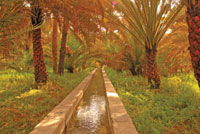
Al Ain is on the Tentative List of World Heritage Sites of UNESCO. This was announced in June this year by Sheikh Sultan bin Tahnoun Al Nahyan, chairman of the Abu Dhabi Authority for Culture and Heritage (ADACH).
The move, which is a preliminary step for Al Ain to make it to the official list, capitalises on the particular cultural wealth of the city and shows that it has been able to keep its originality, despite the UAE’s construction boom featuring a multitude of modern buildings.
The next step is for the UAE to prepare a nomination file to be submitted to the World Heritage Committee for examination, according to a UNESCO representative, and this has to be deposited by February 1 in order to be discussed 18 months later.
Al Ain maintains its local character, cultural value and architectural scale thanks to the late Sheikh Zayed bin Sultan Al Nahyan, the founder of the UAE, who had issued a series of laws and regulations that guaranteed the city would retain its authenticity and cultural features.
UNESCO urges world nations to identify cultural and natural heritage sites, and preserve them because they represent great value for humankind. This is reflected in its convention on the Protection of the World Cultural and Natural Heritage in 1972.
A number of important archaeological sites, historic buildings, and natural areas in Al Ain still maintain their cultural and natural values, settings and authentic fabric, said Mohammed Khalaf Al Mazrouei, director general of ADACH.
“Since the establishment of ADACH in October 2005, the authority was concerned with the inventory, preservation and management of cultural sites through a special plan that adopted the latest methodologies and technology means used internationally.
“ADACH is currently conducting the work of preserving the many forts and historical sites. Whenever possible, the original uses of these buildings will be revived, otherwise new uses will be encouraged so as to integrate these historic buildings in the structure of the city and thus ensure their long term preservation,” Mazrouei added.
On the social level, Al Ain residents still feel proud of, respect and practice old customs and traditions, including traditional wedding celebrations, Bedouin hospitality, traditional hunting and camel racing, use of handicrafts and others, concluded Mazrouei.
Among the features that could give Al Ain this accolade are the invention of the falaj system as an engineering feat; the Hili civilisation with its developed water management system, its fortified settlement architecture and its burial customs; the Jebel Hafit cultural landscape with its prehistoric desert encampments, its 4th millennium funerary landscape, its Islamic falaj system and its oases settlements; Al Ain’s various oases with their mosques, farms and other historic buildings, cradle of Emirati Bedouin culture and symbol of life in the past; the thriving practice of falconry and camel trading and racing; Al Ain’s desert red sand dunes, the natural heritage of Jebel Hafit (for its flora & fauna significance) as well as the oases areas.
Jebel Hafit is notable as it has exceptional value for its geological, archaeological and historic significance as well as its paleonthological, zoological and biological importance. The 1,200 m high mountain, which extends for 13 kilometres from north to south, is believed to have been formed some 25 million years ago; marine fossils found in the site though are far much older, dating between 135 and 70 million years ago.
Studies indicate that Jebel Hafit is habitat to around 118 species of plant, 18 species of mammal (including the Arabian tahr, an endangered wild goat and some living troglobites, which might be unique to the ancient cave passages in Jebel Hafit), 140 species of bird (including the threatened Egyptian vulture) and over 10 different species of reptiles.
